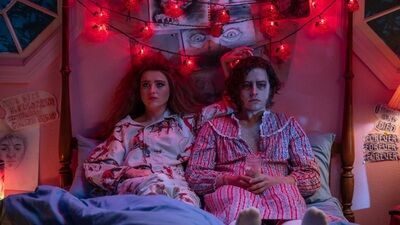“A really fun thing to do in the Frankenstein universe is play with who the monster is,” says Moss. In “birth/rebirth,” which Moss describes as “a cautionary tale about over-identifying with one thing in your life,” pathologist Rose and nurse Celie come together after Rose develops a scientific process to revive the dead—and uses it on Celie’s recently deceased daughter, Lila. Together, the two women go to increasingly grim and harrowing lengths to keep Lila alive. “Our obvious monster is a [reanimated] 6-year-old girl in the film,” says Moss, “but Rose in many ways is a monster, who creates a monster in Celie. And it very much stems from the original novel where the monstrous behavior comes from Victor, not the creature.”
“I think [Frankenstein is] a novel about grabbing power that wasn’t yours to have and what happens when you do that—and then the people who are experiencing the kind of disempowerment, what they’re going to do in order to grab it back,” says Kröger.
This resonates in our current moment, especially in struggles around reproductive autonomy, like the 2022 overturning of Roe v. Wade, and the recent Alabama Supreme Court decision that ruled frozen embryos should be viewed as children. Kröger theorizes that Frankenstein stories might be especially meaningful during times of rightward political shifts, which could check out with the recent history of Franken-cinema—after all, our previous Frankenstein-focused era was the Reagan/Bush era, which saw films like “Re-Animator,” “Weird Science,” and “Edward Scissorhands” flourish. “I just know the more women fear that rights are being taken away and that their world is kind of shrinking and their power is shrinking,” she says, “that we’re going to see more of particular type of character who is like, ‘Okay, I need to process the trauma that the world has given me, and I’m going to do that by fashioning my own path forward.’”
But the Creature doesn’t just symbolize trauma and oppression. The Frankenstein story has also long been used to celebrate outsiders and sexual and gender diversity, especially as it became fodder for transgressive art in the ’70s—most famously with 1975’s “The Rocky Horror Picture Show.”
“The Frankenstein story has often been associated with queerness,” says film critic Abbey Bender. “James Whale, the director of the original 1931 Frankenstein movie, was gay, and Frankenstein often comes up in art that rebels against sexual normativity, like the song ‘Frankenstein’ by the New York Dolls, Lou Reed’s look during his Transformer era, the 1973 movie ‘Flesh for Frankenstein’ (directed by Warhol acolyte Paul Morrissey), the campy 1990 movie ‘Frankenhooker,’ etc.”

